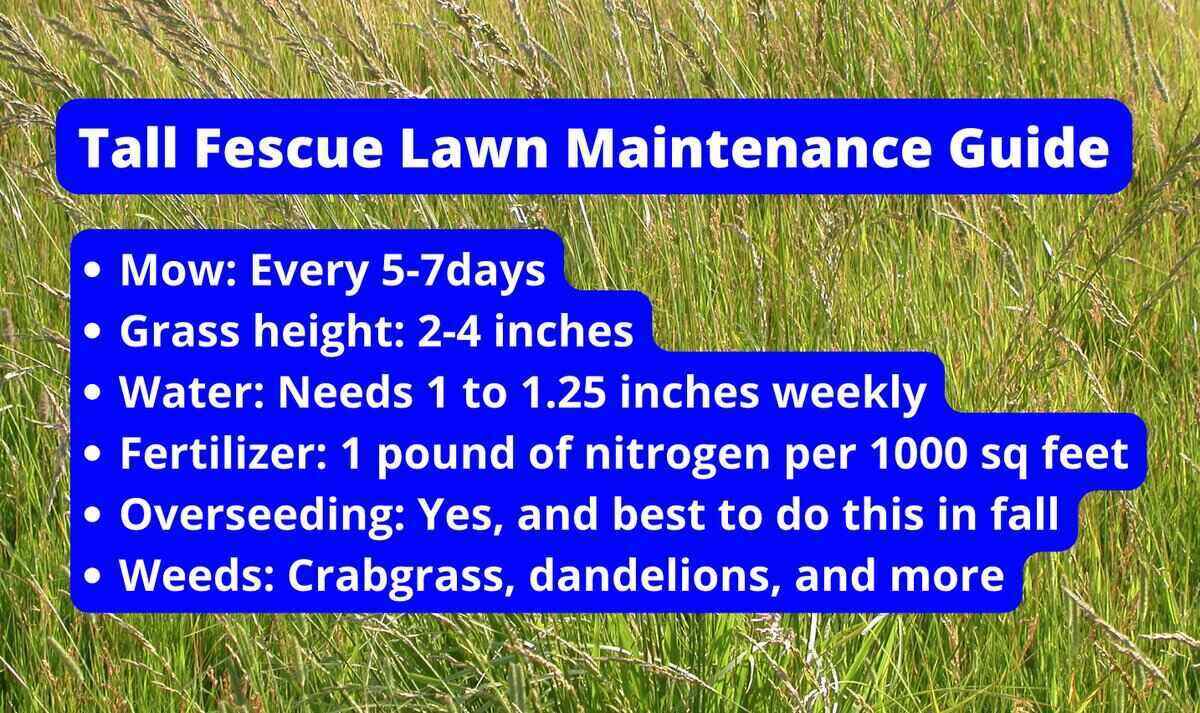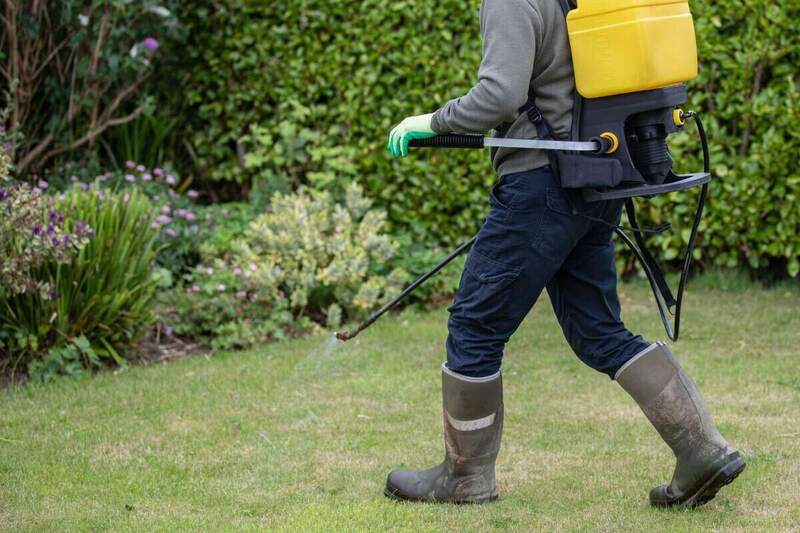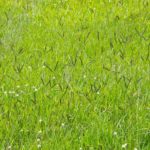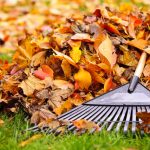
Tall fescue – it’s called “wonder grass” for a reason. It plays an essential role in agriculture, thanks to its long growing period and grazing tolerance, and it’s popular among homeowners for its relatively low maintenance. Whether you already grow this cool-season grass or want to know if it’s right for your lawn, our tall fescue lawn maintenance guide has you covered.
Don’t know when to fertilize your tall fescue lawn? Should you aerate your lawn in fall or spring? Not to worry. Read on to learn how to best maintain your tall fescue grass spring through winter.
What is Tall Fescue?
Tall fescue grass is native to parts of Europe, the Mediterranean, the Middle East, and northern and central Asia. Despite not originating in the Americas, it does well in the upper half of the United States, where cool-season grasses thrive.
What is cool-season grass? Cool-season grass grows actively in the temperate weather of spring and fall but goes dormant in the summer heat, making it suitable for colder northern climates. Tall fescue is more heat and drought-resistant than many cool-season grass types, so it’s a good choice for lawns in the transition zone (aka the middle of the United States).
Note: Do you live in the South? The lower half of the United States is better suited for warm-season grasses.
Tall fescue can grow in many soil types, but it does best in well-drained clay soils with high organic matter. It has moderate to coarse grass blades. The old standard cultivar for lawns is Kentucky-31, but improved tall fescues have a finer texture, better shoot density, darker green color, and higher tolerance for shade and low mowing.
- Classification: Cool-season grass
- Spreads by: Bunch-type grass
- Shade tolerance: Moderate
- Drought tolerance: Moderate
- Traffic tolerance: Moderate, but it doesn’t recover well
- Maintenance needs: Low. Mow every 5 to 7 days and irrigate with one inch of water each week. Depending on the results of a laboratory soil test, expect to fertilize with 1 pound of nitrogen per 1000 square feet during the growing seasons for a yearly total of 3 pounds.
- Recommended mowing height: 2.0 to 4.0 inches (mow down to this height)
Pros and Cons of Tall Fescue
Every grass type has its vices and virtues. Here is why people like tall fescue and why they don’t.
Pros
✔ Low-maintenance
✔ Tolerates heat and drought
✔ Tolerates many soil types and conditions
✔ Not vulnerable to chinch bugs, a common summer lawn pest
✔ Is resistant to the lawn disease dollar spot
✔ It doesn’t generate much thatch, the layer of plant debris that forms on the soil
Cons
✘ Grows in bunches, meaning it won’t fill in gaps quickly
✘ Slow to recover from damage
✘ Vulnerable to the lawn disease brown patch
Tall Fescue Monthly Maintenance Calendar
Want to know how your lawn care schedule will look? This calendar shows how to care for your tall fescue lawn all year. The green check mark represents the best time to complete a task. The black check mark represents a possible time to complete a task. Not all lawn care tasks have ideal times.
Want to know how your local climate affects your lawn care regimen? Contact your local cooperative extension for more information.
| Treatment | Mar | Apr | May | Jun | Jul | Aug | Sep | Oct | Nov | Dec | Jan | Feb |
| Mow | ✔ | ✔ | ✔ | ✔ | ✔ | ✔ | ✔ | ✔ | ✔ | ✔ | ✔ | ✔ |
| Weekly watering | ✔ | ✔ | ✔ | ✔ | ✔ | ✔ | ✔ | ✔ | ✔ | ✔ | ✔ | ✔ |
| Fertilizing | ✔ | ✔ | ✔ | ✔ | ✔ | ✔ | ✔ | ✔ | ||||
| Soil amendments | ✔ | ✔ | ✔ | ✔ | ✔ | ✔ | ✔ | ✔ | ||||
| Aerating | ✔ | ✔ | ✔ | ✔ | ✔ | ✔ | ||||||
| Dethatching | ✔ | ✔ | ✔ | |||||||||
| Seeding | ✔ | ✔ | ✔ | ✔ | ✔ | ✔ | ||||||
| Sod installation | ✔ | ✔ | ✔ | ✔ | ✔ | ✔ | ✔ | ✔ | ✔ | |||
| Pre-emergent weed control | ✔ | ✔ | ✔ | ✔ | ✔ | ✔ | ||||||
| Post-emergent weed control | ✔ | ✔ | ✔ | ✔ | ✔ | ✔ | ✔ | ✔ | ✔ | ✔ | ✔ | ✔ |
| Grub/pest control | ✔ | ✔ | ✔ | ✔ | ✔ | |||||||
| Disease control | ✔ | ✔ | ✔ | ✔ | ✔ | ✔ | ✔ | ✔ | ✔ | ✔ | ✔ |
Tall Fescue Maintenance Tasks
Whether you’re new to lawn care or experienced, it never hurts to get to know the needs and quirks of your grass type. Here are maintenance tips specifically catered to tall fescue lawns.
How to Mow Tall Fescue
Tall fescue grows quickly, so you’ll need to mow it every 5 to 7 days. It actively grows in the spring and fall, so that’s when your mowing will be most frequent. Mow in the summer and winter until it stops growing.
What height should your grass be? Mow your lawn between 2 to 4 inches. Raise your mower height by up to half an inch in the summer to help keep your soil cool and prevent it from drying.
Those leftover grass clippings can provide a nutritional boost for your lawn, reducing the fertilizer you need to use by up to 25%. You can also use the clippings as mulch for your flower beds. However, bag the clippings if your turf is struggling with disease. The clippings could spread the disease further if left on your lawn.
How to Water Tall Fescue
How much water does a tall fescue lawn need? Tall fescue needs about 1 to 1¼ inches of water a week, whether provided by you or mother nature. If your grass goes dormant in the summer, water it with about ½ inch every three weeks to prevent death.
How often should you water? It depends on how much it’s been raining and the time of year. Typically, you should water your lawn once a week if there’s no precipitation. Clay soils absorb water slowly; irrigate until it stops absorbing, wait, then water again. Sandy soils absorb water quickly, so you may need to split watering into two weekly sessions.
Another way to tell if your tall fescue needs water is to look for signs of dehydration or drought stress. Give your grass a drink if it’s dark bluish gray, wilting, folded, curled, or retaining footprints. You may need to water as often as every five days during hot, dry periods.
And remember: It’s healthier for your lawn’s root system to water your grass less frequently and for long periods than to water too frequently and for short periods.
How to Fertilize Tall Fescue
Fertilizer provides your lawn with the nutrients it needs to thrive and survive. It generally contains nitrogen (N), phosphorus (P), and potassium (K). The numerical NPK ratio on the fertilizer package represents the percentage of each nutrient (for example, 16-4-8 would mean 16% nitrogen, 4% phosphorus, and 8% potassium).
A soil test will tell you precisely what your lawn needs by showing you what’s in the soil already. Send a soil sample to your local cooperative extension or soil testing laboratory before you fertilize.
Apply 1 pound of nitrogen per 1000 square feet to your tall fescue grass. You can do this up to three times a year for a total of 3 pounds of nitrogen per 1000 square feet yearly. However, tall fescue does fine in low-fertility soils, and you should always follow the guidance of your soil test results.
The best time of year to fertilize tall fescue grass is in the fall, especially if you plan on fertilizing only once a year. Your turf will need those nutrients to grow, recover from the summer heat, and prepare for winter. You can also fertilize it in spring, the best time being March or early April. However, this is riskier; if you fertilize too early, you could promote an early growth spurt before your grass is ready.
Fertilizing cool-season grass in summer isn’t usually recommended. Your grass could be dormant and unable to utilize the nutrients, or it could suffer from fertilizer burns in the heat.
How to Apply Soil Amendments to Tall Fescue
Soil tests can also teach you about your soil pH. Soil pH measures acidity and alkalinity on a scale of 0 (most acidic) to 14 (most alkaline). The ideal soil pH for turfgrass is usually between 6 and 7, but tall fescue has a broader range. The ideal pH range for tall fescue is between 5.5 and 7.5. If it’s in this range, it will get the following benefits:
- Improved beneficial microorganism activity
- Better nutrient absorption
- Lower chance of toxicity from aluminum and manganese
How do you fix your pH if it’s outside of this range? Apply soil amendments. Soil amendments technically work any time of year as long as there’s no ice, drought, rain, or stress from pests and diseases. Lime (raises pH) works best in the spring or fall, and sulfur (lowers pH) works best in the spring.
These soil amendments will take several months to break down, so wait at least six months before getting another soil test.
How to Aerate Tall Fescue
If your lawn gets a lot of use, your soil may be compacted. Core aeration creates holes in the ground to relieve that compaction. It also provides other benefits:
- Allows nutrients, water, and air to penetrate the soil
- Improves root growth
- Reduces thatch
- Improves drainage
- Helps earthworms
- Boosts the effectiveness of fertilizer, soil amendments, and overseeding
Since tall fescue is a cool-season grass, it’s best to aerate in fall when it’s growing well. That way, it will easily be able to recover from this invasive (though beneficial) procedure. However, you can aerate in spring if soil compaction is causing severe problems for your lawn.
How to Dethatch Tall Fescue
Thatch comprises dead and living shoots, stems, and grass roots. A little is normal, but too much (more than half an inch) can suffocate your lawn and create the perfect environment for pests and diseases. Dethatching tools remove this excess from your turf. Raking and aerating will also remove some thatch.
Luckily for you, tall fescue isn’t prone to thatch. Keep an eye on the thatch level, but you likely won’t need to dethatch your lawn yearly. If you need to dethatch your lawn, fall is a good time.
How to Seed and Overseed Tall Fescue
Seeding is when you spread grass seeds to plant a new lawn. Overseeding is when you spread grass seeds over an existing lawn to fill in patches or make it thicker. Tall fescue is a bunch-type grass, which means it won’t fill in gaps on its own. That means overseeding is especially important for this grass type. Not only will a thicker lawn look better, but it can better resist:
- Pests
- Diseases
- Heat stress
- Weeds
The best time of year to overseed tall fescue is in fall. The best month will depend on your local climate, but it will generally be no later than early October. If you aerate right before, the seeds will have better access to the soil. Keep seeds moist until they germinate.
How to Install Tall Fescue Sod
Want a quicker fix? Install sod to create an instant lawn. Tall fescue can be bought and planted as sod, though it is sometimes mixed with Kentucky bluegrass to improve sod strength.
Make sure to water your sod until it’s had a chance to lay down roots. If you can still easily pull it up, it needs more time. The best time to install tall fescue sod is in spring or fall.
How to Control Weeds in Tall Fescue

Just like any other grass, tall fescue will compete with weeds for space in your yard. Luckily, you have plenty of options to prevent and eliminate them. A healthy lawn will resist weeds better than an unhealthy lawn, so keep up with the rest of your lawn maintenance. You can also pull weeds out with tools or your hands, though you’ll need to remove the entire root system to stop them for good.
If proper lawn care and weed pulling aren’t solving the problem, you can turn to targeted herbicides. Pre-emergent herbicides stop weeds from growing in the first place. For example, you’d apply pre-emergent weed control in spring to prevent summer annual weeds and in fall to stop winter annual weeds. Post-emergent herbicides kill the weeds after they’ve sprouted.
Pro tip: Avoid herbicides in the summer. The combination of heat and chemicals can cause damage to your cool-season grass at a delicate stage in its life cycle. You should also wait to apply herbicides if you have new grass growing.
Below are some weeds to watch out for in tall fescue lawns:
- Annual bluegrass
- Chickweed
- Clover
- Crabgrass
- Cudweed
- Dallisgrass
- Dandelions
- Foxtail
- Goosegrass
- Henbit
- Nutsedge
- Wild garlic
- Wild onion
How to Control Pests in Tall Fescue
Tall fescue doesn’t have too many pests but is slow to recover from the damage they cause. The primary insects that threaten tall fescue lawns are grubs. Grubs are the larval form of beetles that munch on your grass roots.
You’ll know you have a grub problem if wild animals are digging in your yard or you can easily pull up chunks of grass. Improve your lawn maintenance and apply insecticide once you know there’s a problem to prevent further damage.
How to Control Diseases in Tall Fescue
Tall fescue is susceptible to brown patch, a fungal disease that develops in hot, humid weather. It causes brown circles, lesions, and rotting grass. Here are some techniques to keep it in check:
- Aerate and dethatch to increase air circulation and keep turf dryer.
- Avoid excessive nitrogen in high growth periods. While this nutrient feeds your grass, it also feeds this fungal disease.
- Reduce irrigation and improve drainage to get rid of excess moisture. Don’t neglect your grass’ needs, though.
- Water in the morning so your grass can absorb what it needs, then dry out in the sun. Nighttime irrigation encourages fungal growth since the grass can’t dry out. In contrast, daytime irrigation evaporates water before your grass can absorb it.
- Apply fungicide if the above methods have no effect.
Note: Always bag and dispose of grass clippings when your lawn is diseased.
FAQ About Tall Fescue
The composition of your soil is more important than your grass type. Follow the suggestions of your soil test to help choose the best fertilizer for your tall fescue lawn.
Depending on where you live, tall fescue can stay green all year if well-irrigated. Tall fescue will naturally go dormant where summer and winter are harsh.
Here are the most common reasons your tall fescue could die:
• Heat or drought stress
• Excessively moist soil
• Diseases, especially brown patch
Remember: Just because your grass turns brown in the summer or winter doesn’t mean it’s dead. If it’s just dormant, it will green up again with water and mild temperatures.
Want to know what your other options are? Here are the most common cool-season grass types.
• Kentucky bluegrass
• Fine fescue
• Perennial ryegrass
Do you live in the transition zone? You can also consider these warm-season grass varieties:
• Zoysiagrass
• Bermudagrass
When to Hire a Lawn Care Pro
Even though tall fescue is called the wonder grass, you may not feel wonderful while caring for it. Sometimes, you’d rather rely on the expertise of a pro. Let LawnStarter connect you with lawn care professionals who care for all sorts of grass types.
Main Image Credit: Matt Lavin / Flickr / CC BY-SA 2.0 with text overlay


![The Home of LSU’s Mike the Tiger [Infographic]](https://www.lawnstarter.com/blog/wp-content/uploads/2016/08/mike-the-tiger-4-150x150.jpg)


